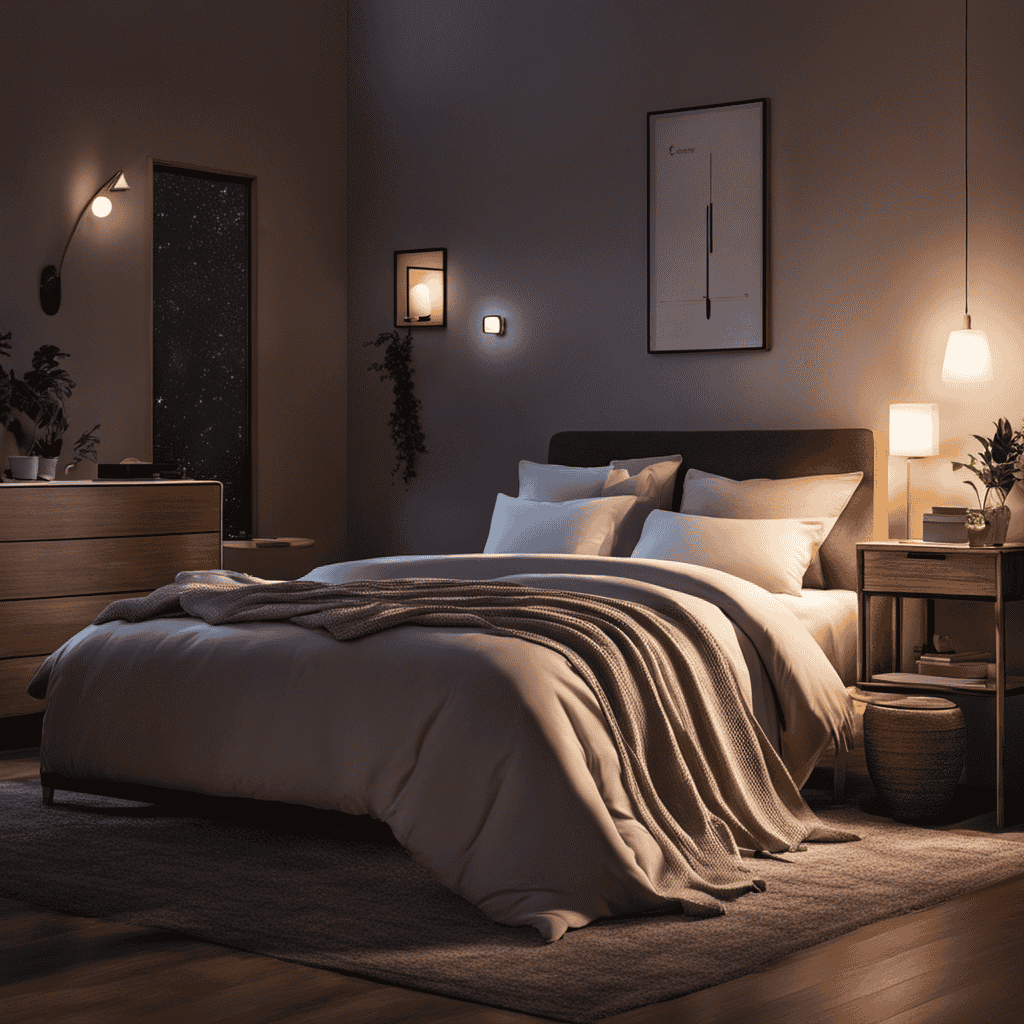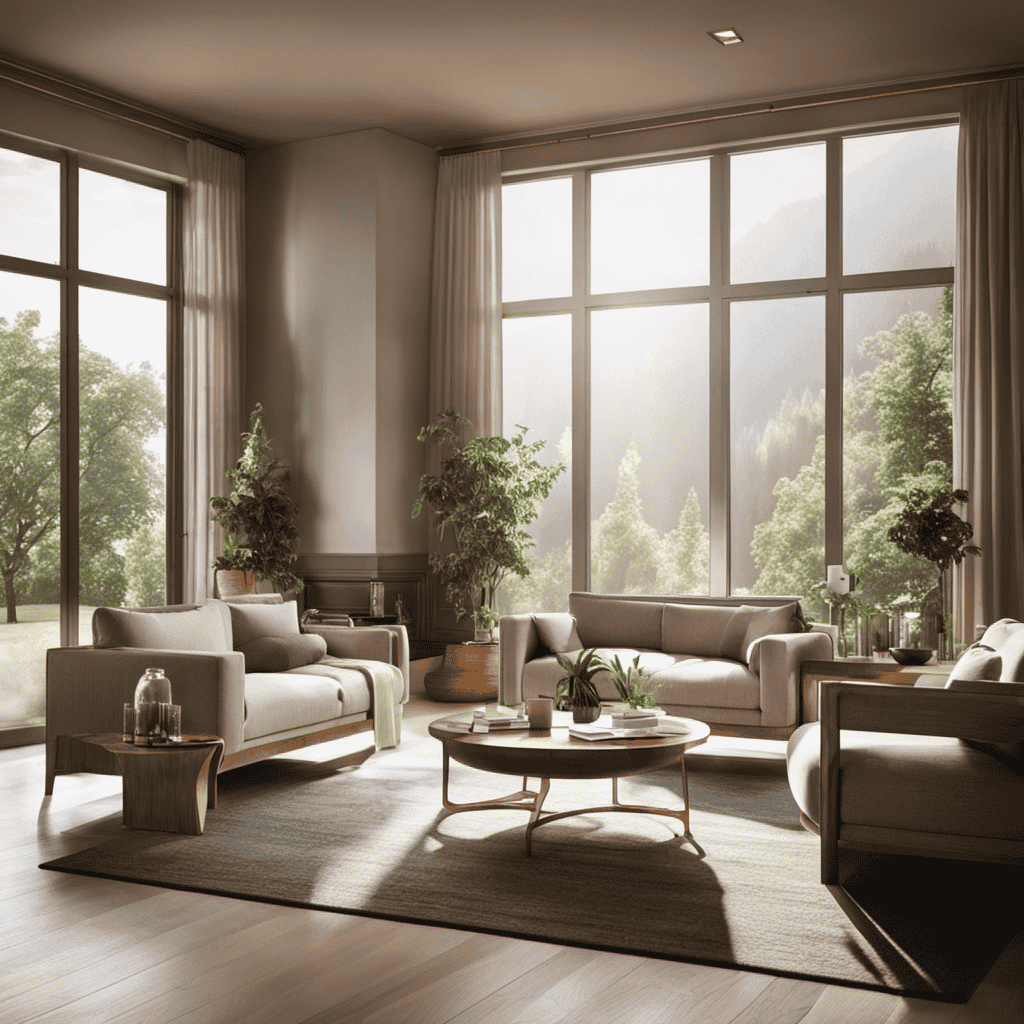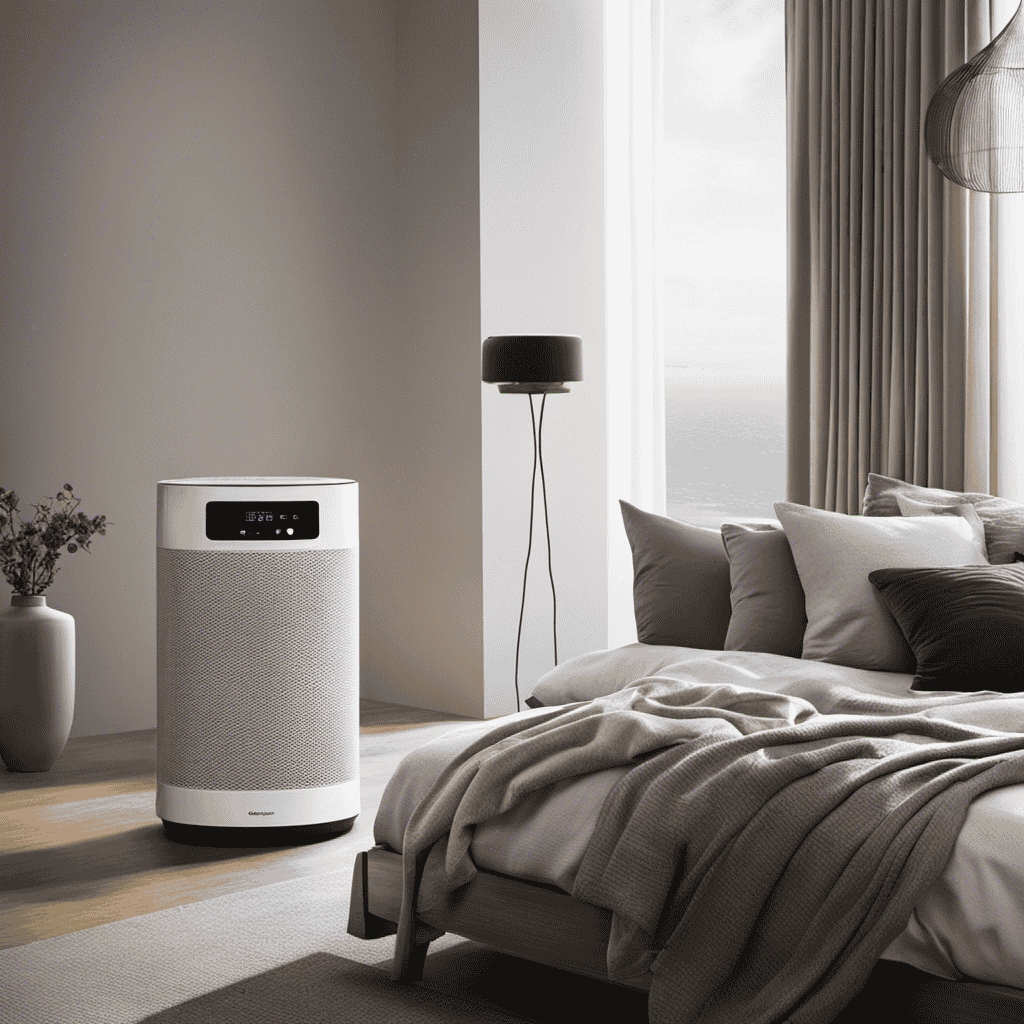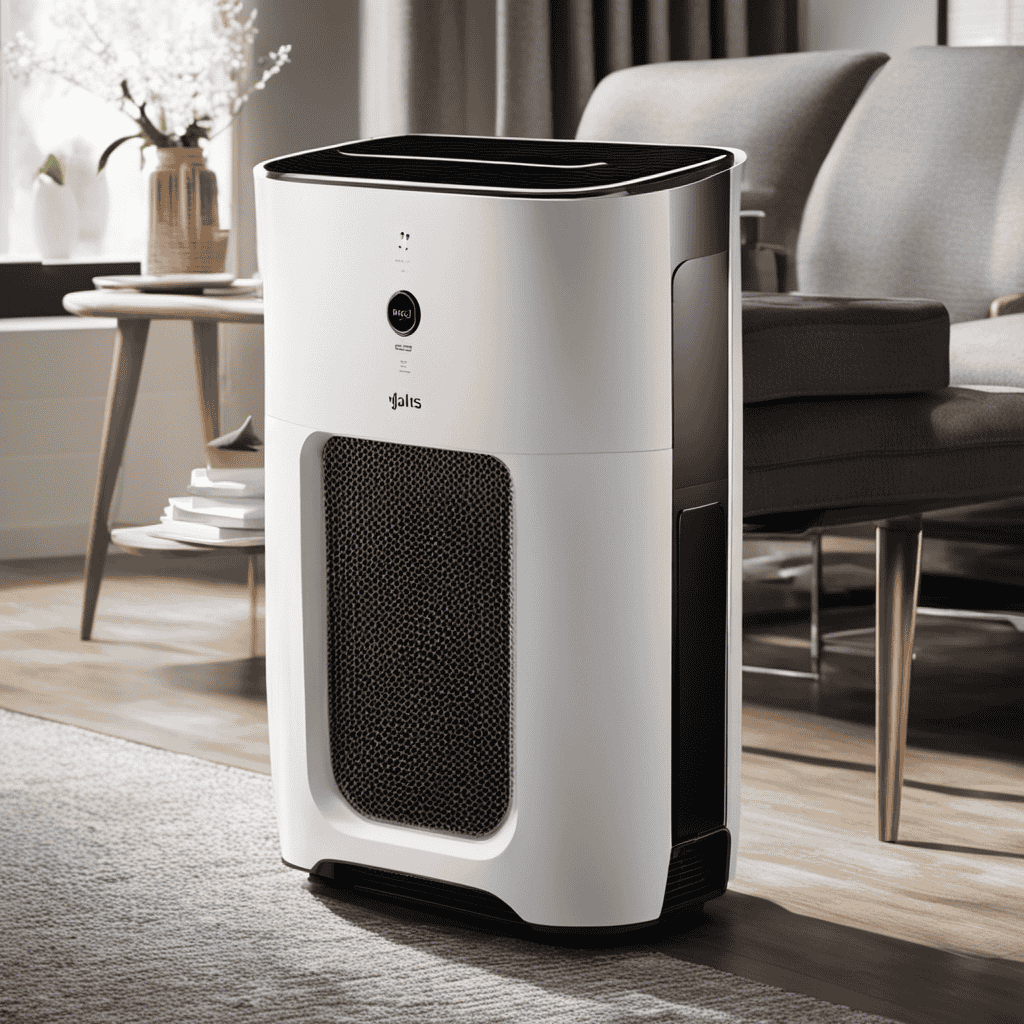Did you realize that on average, people spend approximately 90% of their time indoors? Given the substantial amount of time spent indoors, it is essential to ensure the air we breathe is clean and healthy.
That’s where air purifiers, like the Levoit Air Purifier, come in. In this article, I will guide you through the factors to consider when determining the runtime of your air purifier.
By following recommended guidelines and understanding the relationship between air quality, room size, and purifier usage, you can maximize the benefits of your Levoit Air Purifier.
Key Takeaways
- Consider factors such as room size, air pollution level, and personal preferences when determining air purifier runtime.
- Levoit air purifiers are designed for specific room sizes, so choose the appropriate model for your space.
- The optimal duration for air purification is at least 8 hours a day, but running the purifier continuously for 24 hours is not necessary or energy-efficient.
- To save energy, you can run the purifier for shorter durations, use timer settings, clean or replace filters regularly, and keep windows and doors closed while the purifier is running.
Factors to Consider When Determining Air Purifier Runtime
When deciding how long to leave your Levoit air purifier on, you should consider factors such as the size of the room and the level of air pollution in your environment. It is important to understand that the recommended purifier runtime may vary depending on these factors.
Larger rooms or areas with higher levels of air pollution may require longer runtime to effectively clean the air. To determine the optimal runtime for your Levoit air purifier, you can utilize the air quality monitoring feature. This feature allows the purifier to automatically adjust its operation based on the air quality in your environment.
By monitoring the air quality and adjusting the purifier runtime accordingly, you can ensure that you are getting the best possible performance and clean air in your space.
Now, let’s explore the recommended runtime guidelines for Levoit air purifiers.
Recommended Runtime Guidelines for Levoit Air Purifiers
When it comes to optimal air purification duration, it is important to consider factors such as room size, air quality, and personal preferences.
Levoit air purifiers are designed to effectively clean the air in a specific room size within a certain timeframe, ensuring maximum efficiency.
To save energy, it is recommended to use the air purifier in intervals or based on the air quality needs, rather than running it continuously.
Optimal Air Purification Duration
To ensure optimal air purification, you should leave your Levoit air purifier on for at least 8 hours a day. This recommended runtime allows the air purifier enough time to effectively filter and clean the air in your space. However, it’s important to note that running the purifier continuously for 24 hours is not necessary and may not be energy-efficient. To help you better understand the recommended runtime and to provide energy-saving tips, refer to the table below:
| Recommended Runtime (hours) | Energy-Saving Tips |
|---|---|
| 8 | – Set a timer to automatically turn off the purifier after the recommended runtime. |
| 10 | – Place the purifier in the room where you spend the most time. |
| 12 | – Clean or replace the filters regularly to maintain optimal performance. |
| 14 | – Keep windows and doors closed while the purifier is running. |
| 16 | – Use the lowest fan speed setting to conserve energy. |
Energy-Saving Runtime Suggestions
Running the purifier for shorter durations, such as 8-12 hours, can help conserve energy while still maintaining optimal air purification. By utilizing the timer settings on your air purifier, you can easily schedule the runtime to align with your specific needs and save energy in the process.
Setting the timer to run during times when you are most active in a particular room can ensure that you are breathing clean air without wasting energy when the room is unoccupied. Additionally, consider adjusting the fan speed to a lower setting when the air quality is already good, as this can further reduce energy consumption.
Remember to regularly clean and maintain your air purifier to ensure its efficiency and longevity. By following these energy-saving tips, you can enjoy cleaner air while minimizing your environmental impact.
How Long Should I Run My Air Purifier Each Day
You should aim to run your Levoit air purifier for at least eight hours each day to effectively clean the air in your space. This runtime ensures that the purifier can effectively remove pollutants and allergens from the air, improving the overall air quality.
Keep in mind that running the air purifier for longer periods may result in higher energy consumption. However, Levoit air purifiers are designed to be energy efficient, so you can still enjoy clean air without worrying about excessive power usage.
To further optimize energy consumption, you can also take advantage of the timer function available on some models to schedule specific runtime periods.
Additionally, regular maintenance, such as cleaning or replacing the filters as instructed in the user manual, is essential to ensure optimal performance and prolong the lifespan of your Levoit air purifier.
Understanding Air Quality Levels and Purifier Usage
Make sure you understand the air quality levels in your space and how to effectively use your purifier. It is important to know the recommended purifier settings and understand air purifier filters. Here are four key points to consider:
-
Determine the air quality level in your space: Use an air quality monitor to assess the air quality in your environment. This will help you understand if your purifier needs to be adjusted or if it is working effectively.
-
Set the purifier to the appropriate fan speed: Most air purifiers have multiple fan speeds. Adjust the fan speed based on the air quality level. Higher speeds are recommended for poor air quality, while lower speeds can be used for maintenance.
-
Understand the filtration system: Different air purifiers use different types of filters, such as HEPA filters or activated carbon filters. Familiarize yourself with the specific filters in your purifier and their maintenance requirements.
-
Monitor filter replacement: Air purifier filters need to be replaced periodically to maintain optimal performance. Keep track of the recommended filter replacement schedule and ensure timely replacement.
The Relationship Between Room Size and Purifier Runtime
Understanding the relationship between room size and purifier runtime is crucial for ensuring efficient air purification. The size of the room directly affects the effectiveness of the air purifier in improving air quality.
Larger rooms require longer runtime for the purifier to effectively filter and circulate the air. When determining the appropriate runtime, it is important to consider the air quality measurements in the room.
If the air quality is poor, such as high levels of pollutants or allergens, it may be necessary to run the purifier for a longer period of time. On the other hand, if the air quality is already good, a shorter runtime may be sufficient.
Balancing Energy Efficiency and Air Purification Needs
When it comes to optimizing the runtime of an air purifier, several key factors come into play.
One important consideration is finding the optimal purifier runtime based on the size of the room and the air quality needs.
Additionally, energy-saving modes can be utilized to balance energy efficiency with the necessary air purification requirements.
Optimal Purifier Runtime
To get the most out of your Levoit air purifier, you should consider running it for at least 8 hours a day. This recommended runtime ensures that the air in your space is continuously purified, keeping it fresh and clean.
However, running the purifier non-stop can lead to higher energy consumption and increased electricity bills. To strike a balance between optimal air purification and energy savings, here are some tips:
-
Use a timer: Set the purifier to run for 8 hours during the times when you are most likely to be in the room.
-
Adjust fan speed: Lower the fan speed when the air quality is good, reducing energy usage while maintaining air circulation.
-
Close doors and windows: By sealing off the room, you prevent the purifier from working overtime to clean air from outside.
-
Clean and replace filters regularly: Clogged filters can reduce the efficiency of the purifier, leading to longer runtime and higher energy consumption.
Energy-Saving Modes
Make sure you take advantage of the energy-saving modes available on your purifier to reduce electricity consumption. Levoit air purifiers are equipped with a range of energy-saving features and customizable settings that allow you to optimize their performance while minimizing energy usage. These features not only help you save on your electricity bills but also contribute to a greener and more sustainable environment.
One such energy-saving feature is the programmable timer, which allows you to schedule the operating hours of your purifier according to your needs. This way, you can ensure that the purifier is only running when necessary, saving energy during idle periods. Additionally, many Levoit models have an auto mode, where the purifier adjusts its fan speed and operation based on the detected air quality, reducing energy consumption when the air is already clean.
By taking advantage of these energy-saving modes and customizable settings, you can enjoy the benefits of clean air while being mindful of your energy usage.
| Energy-Saving Features | Customizable Settings |
|---|---|
| Programmable timer | Auto mode |
| Sleep mode | Adjustable fan speed |
| Eco mode | Night light |
Remember to check your purifier’s user manual for specific instructions on how to access and utilize these energy-saving features to maximize their effectiveness.
Air Quality Considerations
When considering how long to leave your Levoit air purifier on, it’s important to take into account the air quality in your surroundings. Poor air quality can have various negative effects on your health, such as allergies and respiratory issues. To ensure optimal air quality, here are some factors to consider:
- Room size: Larger rooms may require longer operating times to effectively purify the air.
- Air pollution levels: If you live in an area with high pollution, it may be necessary to run the purifier for longer periods.
- Allergies or sensitivities: If you suffer from allergies or have sensitivities to certain pollutants, it’s recommended to keep the purifier on for longer durations.
- Room ventilation: If your room lacks proper ventilation, it may be beneficial to run the purifier more frequently.
To maintain the efficiency of your air purifier, regular maintenance such as cleaning or replacing filters is essential. This ensures that your purifier continues to effectively remove pollutants from the air.
The Impact of Air Pollutants on Air Purifier Runtime
Air pollutants can significantly affect how long you should leave your Levoit air purifier on. The performance of an air purifier can be influenced by various factors, including the presence of air pollutants in the environment. When there are high levels of pollutants such as dust, allergens, smoke, or volatile organic compounds (VOCs), it is advisable to leave the air purifier running for an extended period of time.
This allows the purifier to continuously filter and clean the air, ensuring a healthier indoor environment. Extended air purification offers several benefits, such as reducing the concentration of harmful particles, improving respiratory health, and minimizing the risk of allergies and respiratory illnesses.
Therefore, it is important to consider the level of air pollutants present and keep the air purifier running for longer durations to optimize its performance and maximize the benefits of clean air.
Optimal Run Times for Different Air Purifier Settings
When it comes to air purifiers, there are a few key considerations to keep in mind regarding optimal run times.
First, you’ll want to weigh the benefits of short versus long runs. Short runs can be effective for quickly improving air quality in a specific area, while long runs can provide continuous purification throughout the day.
Second, energy efficiency should be taken into account, as longer runs may consume more electricity.
Lastly, finding the ideal sleep mode duration is important for maintaining a clean and comfortable sleeping environment.
Short Vs. Long Runs
To get the best results, you should consider running your Levoit air purifier for both short and long periods of time. Here are four reasons why:
-
Air purifier effectiveness: Running your air purifier for short periods may not be sufficient to effectively clean the air in your space. To ensure maximum effectiveness, it is recommended to leave the purifier on for longer durations.
-
Removal of airborne pollutants: Air purifiers are designed to capture and remove various pollutants such as dust, pollen, pet dander, and mold spores. Continuous operation allows the purifier to consistently filter the air, providing you with cleaner and healthier indoor air quality.
-
Elimination of odors: By running your air purifier for extended periods, you can effectively eliminate odors caused by cooking, pets, or other sources. The purifier’s activated carbon filters work to absorb and neutralize odorous particles, leaving your space smelling fresh and clean.
-
Health benefits: Consistent use of an air purifier can have numerous health benefits. It helps reduce allergy symptoms, asthma attacks, and respiratory issues by removing allergens and irritants from the air. Moreover, cleaner air promotes better sleep, improved concentration, and overall well-being.
Energy Efficiency Considerations
Running your air purifier on low power mode can help conserve energy and reduce your electricity bill. Many air purifiers come with energy-saving features, such as adjustable fan speeds, timers, and sleep mode. By utilizing these features, you can customize your air purifier’s performance to meet your needs while minimizing energy consumption.
For example, running your air purifier on low power mode during periods when you are not at home or during the night can significantly reduce energy usage without compromising air cleaning efficiency. This not only helps save energy and lower your electricity bill but also promotes a more sustainable lifestyle.
Now let’s explore the ideal sleep mode duration for your air purifier.
Ideal Sleep Mode Duration
Using the sleep mode feature on your air purifier can help conserve energy and promote a more sustainable lifestyle. Here are a few considerations when determining the ideal sleep mode duration for your air purifier:
-
Room size: The size of your room plays a role in determining the duration of sleep mode. Larger rooms may require a longer sleep mode duration to effectively clean the air.
-
Air quality: If the air quality in your area is poor, you may want to increase the sleep mode duration to ensure thorough purification.
-
Noise level: If the noise from your air purifier bothers you while sleeping, you may want to decrease the sleep mode duration to minimize disruption.
-
Seasonal changes: Adjusting the purifier runtime based on seasonal changes can optimize energy consumption. For example, in spring when pollen is high, a longer sleep mode duration may be necessary.
Adjusting Purifier Runtime for Seasonal Air Quality Changes
It’s important to consider adjusting the runtime of your Levoit air purifier based on seasonal changes in air quality.
As the seasons change, so does the quality of the air we breathe. During certain times of the year, such as spring when pollen levels are high, you may need to increase the runtime of your air purifier to ensure optimal air quality in your home.
On the other hand, during seasons with improved air quality, you may be able to decrease the runtime of your purifier.
By adjusting the purifier schedule based on seasonal air quality improvements, you can ensure that your air purifier is running efficiently and effectively. This will not only help maintain clean air in your home but also help prolong the lifespan of your purifier.
Now, let’s discuss the optimal air purifier runtime for allergen control.
Air Purifier Runtime for Allergen Control
To control allergens effectively, you’ll want to adjust the runtime of your Levoit purifier based on the specific needs of your home. There are several factors that can affect the performance of your air purifier and determine the recommended runtime for asthma relief.
Here are four key considerations:
-
Room Size: Larger rooms may require longer runtime to ensure all the air is properly filtered. Smaller rooms, on the other hand, may need less time.
-
Allergen Levels: If you have high levels of allergens in your home, such as pet dander or pollen, you may need to run the purifier for longer periods to achieve relief.
-
Air Quality: If your indoor air quality is consistently poor, due to factors like smoking or nearby construction, you may need to run the purifier continuously or for extended periods.
-
Personal Sensitivity: Individuals with severe asthma or allergies may need to run the purifier for longer durations to maintain a clean and allergen-free environment.
Considering these factors, it is recommended to run your Levoit air purifier for at least 8 hours a day to effectively control allergens and provide relief for asthma symptoms.
Purifier Usage for Odor and VOC Removal
For effective odor and VOC removal, consider adjusting the runtime of your Levoit purifier based on the specific needs of your home.
The ideal runtime for purifier effectiveness varies depending on factors such as room size, level of odor or VOCs present, and the overall air quality.
In general, running the purifier continuously for 24 hours can provide optimal results. However, if the odor or VOCs are particularly strong, it may be necessary to extend the runtime for a few days until the air quality improves.
It is important to note that running the purifier for longer periods does not necessarily mean better results. The key is to find the balance between runtime and energy consumption, while still achieving the desired odor and VOC removal.
Air Purifier Runtime for Pet Dander and Hair Removal
When it comes to removing pet dander and hair, the runtime of your Levoit air purifier plays a crucial role. Here are four factors to consider for optimal performance:
-
Air purifier runtime for dust removal: Pet dander tends to settle on surfaces and can become airborne when disturbed. To effectively remove it, it is recommended to run your air purifier continuously, especially in areas where your pets spend most of their time.
-
Air purifier runtime for smoke elimination: If you have smokers in your home or frequently encounter smoke from other sources, running your air purifier for extended periods can help eliminate the lingering smoke particles and odors.
-
Pet shedding frequency: The more your pets shed, the longer you may need to run the air purifier to maintain clean air quality.
-
Room size and air purifier capacity: Larger rooms or spaces may require longer runtime or a higher-capacity air purifier to effectively remove pet dander and hair.
Transitioning into the next section, it is important to understand the significance of continuous air purification for maintaining a healthy indoor environment.
The Importance of Continuous Air Purification
When it comes to air purification, continuous operation offers several benefits.
Firstly, it ensures that the air in your indoor environment is consistently clean and free from pollutants.
Secondly, a longer duration of purification allows for more effective removal of contaminants, especially those that are persistent or recurrent.
Lastly, the impact on indoor air quality is significant, as continuous purification helps reduce allergens, odors, and other harmful particles, creating a healthier and more comfortable living space.
Benefits of Continuous Purification
Continuous purification with a Levoit air purifier can help improve air quality by removing pollutants and allergens. Here are four optimal purification strategies and the health benefits of continuous purification:
- Set the purifier on a high fan speed to maximize air circulation and filtration efficiency.
- Keep the purifier running 24/7 to continuously eliminate pollutants and maintain clean air.
- Place the purifier in the room where you spend the most time to ensure the air you breathe is of the highest quality.
- Regularly replace the filters to maintain the purifier’s effectiveness and prevent the buildup of pollutants.
By implementing these strategies, you can experience multiple health benefits. These include reduced allergy symptoms, relief from respiratory issues, improved sleep quality, and decreased risk of respiratory infections.
It is important to understand the duration for effective purification to fully optimize the benefits of continuous air purification.
Duration for Effective Purification
When it comes to the optimal duration for running your Levoit air purifier, several factors should be taken into consideration. These factors include the size of the room, the level of air pollution, and your personal preferences. To help you understand the recommended durations, I have prepared a table below:
| Room Size | Level of Air Pollution | Optimal Duration |
|---|---|---|
| Small | Low | 4-6 hours |
| Medium | Moderate | 8-10 hours |
| Large | High | 12-14 hours |
Impact on Indoor Air
To understand how air purifiers affect indoor air quality, you can explore the impact of these devices on different pollutants and allergens present in your space. Here are four ways air purifiers can improve indoor air:
1) Filtration: Air purifiers use filters to trap and remove particles such as dust, pollen, pet dander, and mold spores from the air. This helps reduce the concentration of these allergens and improves air quality.
2) Odor Removal: Air purifiers equipped with activated carbon filters can also help eliminate unpleasant odors caused by cooking, pets, or smoke. The carbon filters absorb and neutralize odor-causing molecules, leaving the air smelling fresh.
3) Smoke and VOCs Reduction: Air purifiers with specialized filters can effectively capture smoke particles and volatile organic compounds (VOCs) emitted by household products, paints, and cleaning chemicals. This can significantly reduce the harmful impact of air pollution on your health.
4) Asthma and Allergy Relief: By removing common allergens and irritants from the air, air purifiers can provide relief for asthma and allergy sufferers. They create a cleaner and healthier environment, reducing symptoms and improving overall well-being.
Addressing Noise Concerns With Longer Purifier Runtime
If you’re worried about the noise, you can try running your Levoit air purifier at a lower speed for longer periods of time. This method can help in reducing the noise produced by the purifier while still maintaining its effectiveness in purifying the air.
Levoit air purifiers are designed with noise reduction technology, ensuring a quieter operation compared to other models. By using the lower speed setting, the purifier will operate at a lower fan speed, resulting in reduced noise levels.
Additionally, Levoit air purifiers often come with a sleep mode feature. Activating this mode will further decrease the noise produced by the purifier, making it suitable for use during sleep without causing disturbances.
Signs That Indicate You Need to Increase or Decrease Purifier Runtime
After addressing noise concerns with longer purifier runtime, it is important to understand the signs that indicate the need to adjust purifier settings.
Factors affecting air purification can vary, and being aware of these signs can help optimize the performance of your Levoit air purifier.
Here are four indicators that suggest a change in purifier runtime:
-
Increased dust or odor: If you notice a buildup of dust or persistent odors in your home, it may be a sign that the purifier needs to run for a longer duration to effectively filter the air.
-
Allergies or respiratory issues: If you or your family members are experiencing an increase in allergy symptoms or respiratory discomfort, it may be necessary to increase the purifier’s runtime to improve air quality.
-
Environmental changes: Factors such as seasonal changes, construction work, or nearby pollution sources can affect air quality. Adjusting the purifier settings accordingly can help combat these changes.
-
Pet presence: If you have pets that shed fur or dander, it may be necessary to increase the purifier’s runtime to effectively remove allergens from the air.
Frequently Asked Questions
Can the Levoit Air Purifier Run Continuously Without Any Breaks?
Running the Levoit air purifier continuously without breaks has its benefits. Increasing air purifier runtime ensures consistent purification, improving indoor air quality. However, consult the manufacturer’s guidelines for specific recommendations on usage duration.
What Are the Signs That Indicate I Need to Increase the Runtime of My Air Purifier?
Increasing the runtime of your air purifier can have several benefits for air purifier maintenance. Signs that indicate the need for longer runtime include increased dust and allergen levels in your home.
Are There Any Specific Air Quality Levels That Require Longer Runtime for the Air Purifier?
When it comes to specific air quality levels, it is important to consider the necessary runtime for your air purifier. Factors such as pollution levels and allergen presence may require longer operation to ensure optimal purification.
How Does Adjusting the Air Purifier Runtime for Seasonal Air Quality Changes Impact Its Effectiveness?
Adjusting the air purifier runtime for seasonal air quality changes impacts its effectiveness and energy consumption. It’s important to find the right balance to ensure optimal performance and energy efficiency.
Can Running the Air Purifier for Longer Periods of Time Reduce Noise Concerns?
Running the Levoit air purifier for longer periods of time can help reduce noise concerns. However, it’s important to consider the impact on energy consumption and filter lifespan. Prolonged use may increase both.
Conclusion
In conclusion, determining the optimal runtime for your Levoit air purifier depends on various factors such as air quality levels, room size, and specific needs like pet dander removal.
It is recommended to run the air purifier continuously to ensure constant purification. However, noise concerns can be addressed by adjusting the runtime accordingly.
By following the guidelines and recognizing signs that indicate the need for adjustment, you can effectively improve the air quality in your home.
Remember, clean and fresh air is the key to a healthier and more comfortable living environment.










